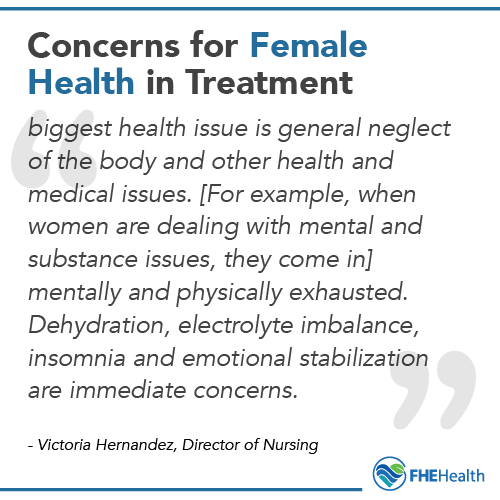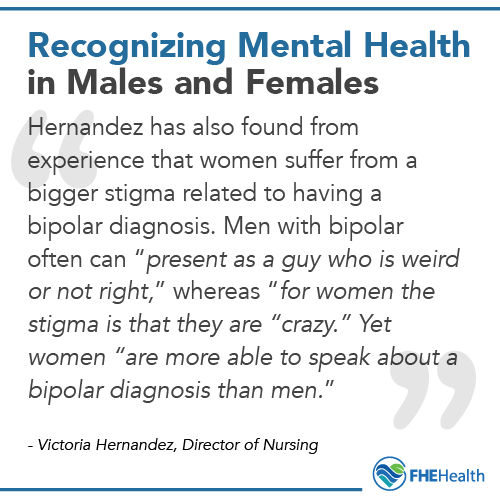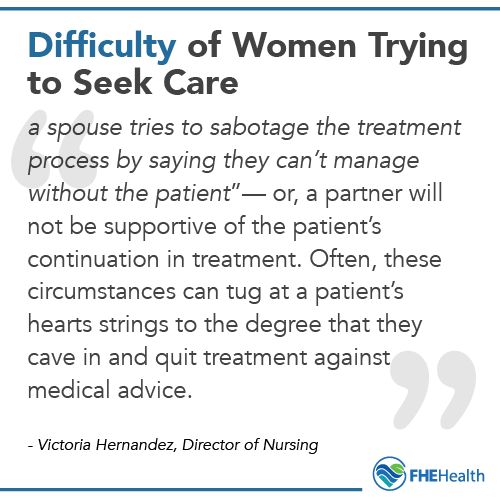
This article has been reviewed for accuracy by our peer review team which includes clinicians and medical professionals. Learn more about our peer review process.
Of the roughly 7-10 million Americans who needed treatment for co-occurring mental health conditions in 2008, according to an estimate by the U.S. Department of Health and Human Services, women represented nearly half of that number, a study in the Journal of Addictions Nursing reported. Today those figures have remained relatively unchanged. Meanwhile, women continue to face unique treatment concerns and obstacles to getting much-needed care for mental disorders and/or co-occurring addictions.
What, then, are the unique treatment needs and top health concerns of women who enter treatment for co-occurring issues? FHE Health Director of Nursing Victoria Hernandez is well-qualified to answer this question and others and recently agreed to share her expertise with us….
Common Women’s Health Issues – Physical and Mental
 What are the most common health concerns among female patients when they first enter treatment? The “biggest health issue” that Hernandez sees among this population is “general neglect of the body and other health and medical issues.” For example, women with co-occurring substance abuse and eating or other mental disorders are often “mentally and physically exhausted. Dehydration, electrolyte imbalance, insomnia and emotional stabilization are immediate concerns.”
What are the most common health concerns among female patients when they first enter treatment? The “biggest health issue” that Hernandez sees among this population is “general neglect of the body and other health and medical issues.” For example, women with co-occurring substance abuse and eating or other mental disorders are often “mentally and physically exhausted. Dehydration, electrolyte imbalance, insomnia and emotional stabilization are immediate concerns.”
Medical neglect can adversely impact mental health, moreover. (This is why FHE Health takes an integrated approach to treatment, recognizing that patients’ outcomes improve when a multidisciplinary medical team addresses both their underlying physical issues and related mental health conditions.)
Bipolar Disorder and Women’s Mental Health Services
 Bipolar disorder is a commonly occurring mental health condition among female patients. This mood disorder, marked by dramatic “manic” highs and sometimes dangerously depressive lows, can tend to affect women differently than it affects men. For example, a 2015 study in the Indian Journal of Psychiatry found that, “Co-morbidity, particularly thyroid disease, migraine, obesity, and anxiety disorders occur more frequently in women [with bipolar] while substance use disorders are more common in men [with bipolar].”
Bipolar disorder is a commonly occurring mental health condition among female patients. This mood disorder, marked by dramatic “manic” highs and sometimes dangerously depressive lows, can tend to affect women differently than it affects men. For example, a 2015 study in the Indian Journal of Psychiatry found that, “Co-morbidity, particularly thyroid disease, migraine, obesity, and anxiety disorders occur more frequently in women [with bipolar] while substance use disorders are more common in men [with bipolar].”
Hernandez agreed that of the above medical issues that research has identified as more common among female bipolar patients, loss of control, behavioral outburst and emotional dysregulation are the more common problems that she and her nursing staff encounter.
Hernandez has also found from experience that women suffer from a bigger stigma related to having a bipolar diagnosis. Men with bipolar often can “present as a guy who is weird or not right,” whereas “for women the stigma is that they are “crazy.” Yet women “are more able to speak about a bipolar diagnosis than men.”
Hernandez said the first treatment priority for women with bipolar disorder is to get a baseline without illicit substances. From there, (once a diagnosis of bipolar has been made), our nursing staff seeks to accommodate any issues that a bipolar patient may be experiencing and to facilitate the patient’s plan of treatment:
- If the patient is in a manic phase and not eating, the nursing staff will put meals away for them and at breakfast and other meals gently remind the patient that she needs to eat.
- They also encourage staying hydrated and nutritional supplementation.
- They work to ensure that the patient takes her meds as prescribed.
- They encourage the patient to be actively involved in the treatment process and planning.
Other Gender Differences in Mental Health – Women and Eating Disorders
In addition, Hernandez said eating disorders are another co-occurring mental health issue that disproportionately affects women who enter treatment at FHE Health (as opposed to men). Hernandez’s more anecdotal experience on this front helps to illustrate a larger statistical finding: that 90 percent of people with eating disorders are women between the ages of 12 and 25, according to the Substance Abuse and Mental Health Services Administration.
Eating disorders most often tend to co-occur with substance abuse, Hernandez noted. As for the presenting medical needs of this population and how nursing addresses these treatment needs? Hernandez said that she and her staff regularly attend to and monitor issues such as “electrolyte imbalance, low BMI (body mass index), and potential cardiac issues.”
Women’s Emotional Health – Caregiving Role and PTSD and Trauma
For newly admitted female patients who may have left families and caregiving positions in order to seek treatment, the biggest health-related concerns tend to be emotional in nature. Hernandez said women who have to leave important caregiving positions in their family, whether as a spouse, mother or child of an elderly parent, can often struggle with feelings of guilt and second thoughts about why they’re in treatment. Many women who come to treatment worry about “being by themselves [away from home], leaving their families and feeling like they are the caretakers holding the family together.”
The Emotional Pressure of Caregiving Responsibilities
 That immense pressure can be enough on its own to cause a woman to second guess their decision to get treatment. In some cases, though, a spouse or other family member will further amplify this pressure to quit treatment prematurely, according to Hernandez. She said she has seen situations where “a spouse tries to sabotage the treatment process by saying they can’t manage without the patient”— or, a partner will not be supportive of the patient’s continuation in treatment. Often, these circumstances can tug at a patient’s heart strings to the degree that they cave in and quit treatment against medical advice.
That immense pressure can be enough on its own to cause a woman to second guess their decision to get treatment. In some cases, though, a spouse or other family member will further amplify this pressure to quit treatment prematurely, according to Hernandez. She said she has seen situations where “a spouse tries to sabotage the treatment process by saying they can’t manage without the patient”— or, a partner will not be supportive of the patient’s continuation in treatment. Often, these circumstances can tug at a patient’s heart strings to the degree that they cave in and quit treatment against medical advice.
When Hernandez and her nursing staff encounter these sorts of situations, they strive to offer the emotional support that these women will need to finish a plan of treatment:
- They remind female patients that they need to get better for themselves in order to truly provide care for their loved ones;
- And, when one or more family members appears to be sabotaging the treatment process, Hernandez and her team invite a conversation around enmeshment (encouraging the patient to reflect on why it’s so hard to separate from one or more family members for a temporary period of time).
- The goal of these supportive conversations is to help vulnerable female patients stay in treatment and “see there’s hope when they take their meds and experience an improvement.”
In other words, the whole issue of family dynamics can require sensitivity not just on the part of clinical staff and therapists— nurses can also serve a constructive role here, by encouraging patients to engage in self-reflection about their priorities while in treatment. After all, patients’ #1 priority is to get better so they can be well for their families.
Sensitivities Regarding Trauma and PTSD
In addition to sensitivities around family dynamics, women’s mental health services must also be sensitive to potential emotional issues stemming from a past experience of trauma or an ongoing diagnosis of PTSD. Here’s how Hernandez described the sensitivities that she’s careful to exercise in psychiatric nursing:
We have to identify [patients’] fears and mistrust. Knowing about their background and history helps, because while touching on the hand may be a gesture of compassion for one person, touching the hand of a survivor of sexual trauma may be a trigger.
Ultimately, then, while the psychiatric nursing team is here to implement a female patient’s plan of treatment and encourage them to follow it, they end up enlisting a range of aptitudes in that effort.






